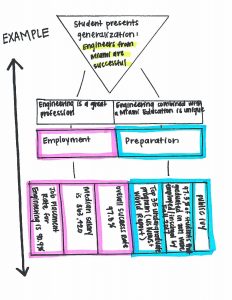Unit 1: Miami University Power Point with CBCI
My classroom is the Admission Visit Center, but I am still a “teacher” in the sense that I teach students about Miami. I’d like to apply the Concept Based Curriculum Instruction to the admission presentations we do for prospective families. This is essentially a PowerPoint with a TON of information about Miami University – merit scholarships, applications dates, statistics and ratings.
- Concept Based Curriculum and Instruction to be applied by adding a series of questions throughout the slideshow
- “adapt[ing] lower level curriculum materials to teach for deeper understanding” (Erickson 10)
- I cannot change slideshow info (because it is copyrighted) but I can enhance slides through what I say
- Slideshow reveals facts and it’s my job to introduce the concepts and generalization thinking
- MTR – Making Thinking Relevant – how does all the information that I am spewing out have any relation??
- Concept: College is necessary in order to excel. Being a college graduate with a minimum bachelor degree allows for more career growth opportunities.
- Conceptual lens: college degree/no college degree
- Enduring Understanding: Miami is a public ivy offering a rigorous academic environment designed to prepare you for success. Attending Miami will prepare you for the future.
- Guiding concepts: Higher Education is necessary to get a distinguished job; Higher Education develops critical thinking; A Liberal Arts foundation is necessary to continue developing/learning as a working adult.
- Guiding Questions
- Factual questions:
- What is Miami’s ranking according to US News and World Report?
- How long has Miami been considered the #1 institution for undergraduate teaching?
- What about Miami’s size (17,200) makes it little and big?
- Conceptual Questions:
- What other schools can offer a rigorous academic environment?
- Where do we see other examples of liberal arts education and well roundness in our life? Why does Miami choose to embrace this platform?
- Everyone’s path is different but the end goal is the same: becoming employed
- Debate Question:
- Can one be as successful without a college degree?
- Factual questions:
Unit 2: Counseling 1:1
CBCI can be used in a counseling session with a student or family.
- These sessions are specific to an area of study as students often want to learn more information on a major/program in order to make a decision about their college destination
- CBCI can be used almost in a reverse “Structure of Knowledge Model” where the student shares the concept and/or generalization and I provide the topic/facts
- Hopefully the topic/facts provided match what the student is looking for
- EXAMPLE: A student is looking for an engineering program for their college studies

- What is drawn here is a model that can be used reversely (as mentioned) and traditionally, hence the arrow point both ways. Since each counseling session is unique, I’ve prepared a model that could be used in situations where I present a generalization and the student presents a generalization.
From the presentation or counseling session, hopefully students are able to gather a worldly end product that is applicable to life. It’s not just about facts, but how this information enhances your knowledge.
I learned that CBCI is really about applying the knowledge you’re learning and making it applicable for life. It’s not just retaining information to get a good score on a test. I consulted Google, Twitter (@Clip_School) and Google Images (visual learner).
